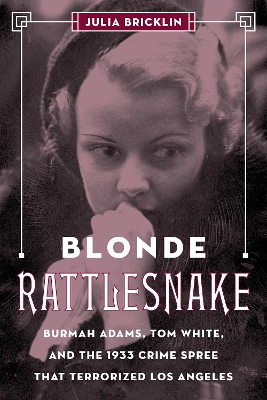
Nineteen-year-old Burmah Adams, a hairdresser and former Santa Ana High School student, spent her honeymoon on a crime spree. She and her husband of less than one week, White, an ex-con, robbed at least twenty people in and around downtown L.A. at gunpoint over an eight-week period. But the worst of their crimes was the shooting of a popular elementary school teacher, Cora Withington, and a former publisher, Crombie Allen, who was teaching her how to drive his new car.
A few days later, a watchful pair of patrolmen in a Westlake neighborhood called their detective colleagues at the Los Angeles Police Department; they had spotted a car that looked like one the duo had stolen days before. Two of these detectives dressed as mechanics and kept an eye on the apartment building until Burmah and Thomas appeared one afternoon. As police swarmed the building, Burmah tried to hurl herself out of a third-story window, while Thomas shot at officers and was immediately gunned down and killed.
Blond Rattlesnake reveals the events that brought Adams and White together and details the crime spree they committed in the sweltering hot days and nights of Los Angeles in the height of the Great Depression. It describes the terror of citizens in their path and the outrage they directed at the female half of the duo. Politicians exploited Burmah's incarceration and trial for their own purposes as the press battled for scoops about the "Blonde Rattlesnake" and created sensation while trying to make sense of her crimes.
Blonde Rattlesnake is a thought provoking book. Not particularly immersive or nail-biting, it nonetheless tells Burmah Adams White's story in a fairly unbiased way, unlike the newspapers and radios of the time of her arrest and trial. While the book includes some of those, the author also includes quotations from Burmah herself, as well as from her mother. Unlike many biographical fiction books, there is not any creative nonfiction here, it is strictly written in a journalistic style.
The book focuses less on the crimes committed - though there is plenty of page time given to those - than on the corruption in the California legal system in the 1930s, and whether or not Burmah actually received a fair trial. Also on the WHY she acted as she did, which is never answered fully enough to truly decide. No doubt as many people at the time did, some readers will decide for themselves whether or not she acted of her own free will or if she was coerced by an abusive husband, but for myself, I was never completely satisfied and couldn't state an opinion either way.
3.5/5 stars, rounded up.
Many thanks to Netgalley and the publisher for an eARC in exchange for an honest review.
Blog | Twitter | Bloglovin | Instagram |
Reading updates
-
Started reading
-
30 March, 2019:
Finished reading
-
30 March, 2019:
Reviewed
